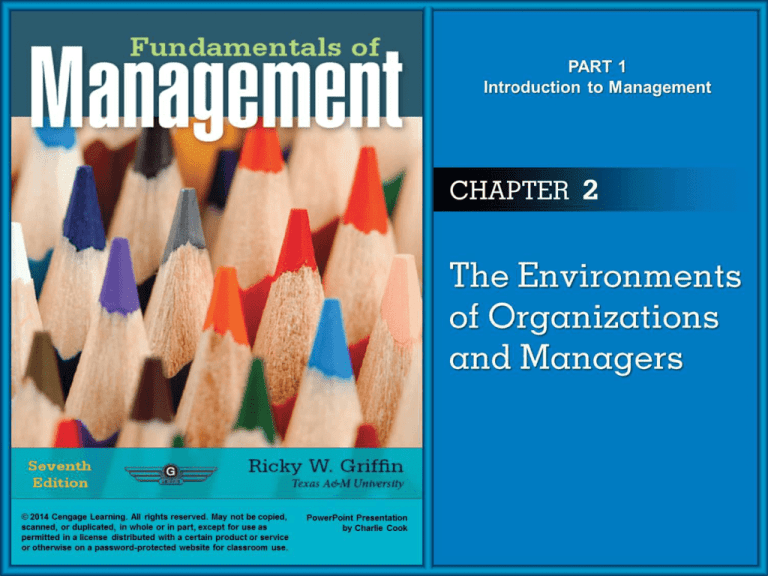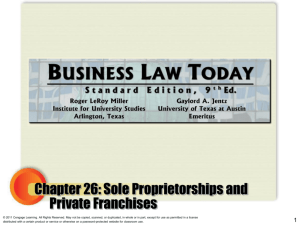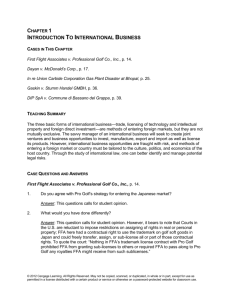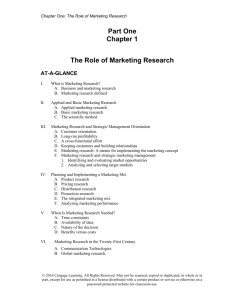
Chapter Learning Objectives
After studying this chapter you should be able to:
1. Discuss the nature of an organization’s environments and
identify the components of its general, task, and internal
environments.
2. Describe the ethical and social environment of management,
including individual ethics, the concept of social responsibility,
and how organizations can manage social responsibility.
3. Discuss the international environment of management, including
trends in international business, levels of international business
activities, and the context of international business.
4. Describe the importance and determinants of an organization’s
culture, as well as how organization culture can be managed.
© 2014 Cengage Learning. All rights reserved. May not be copied, scanned, or duplicated, in whole or in part, except for use as
permitted in a license distributed with a certain product or service or otherwise on a password-protected website for classroom use.
2–2
FIGURE 1.4
The Systems Perspective of Organizations
Remember Systems Theory?
Based on interaction
with the external
ENVIRONMENT of the
system
© 2014 Cengage Learning. All rights reserved. May not be copied, scanned, or duplicated, in whole or in part, except for use as
permitted in a license distributed with a certain product or service or otherwise on a password-protected website for classroom use.
1–3
Systems Theory and Actual Management
• The study of management has sometimes
focused on factors within the organization – a
closed system view. However, to be effective,
managers must monitor and respond to the
environment – an open systems view.
• Explain from a system’s theory perspective.
The Organization’s Environments
• External Environment
– General environment is a set of broad dimensions
and forces in an organization’s surroundings that
determine its overall context
– Task environment is composed of specific groups
and organizations that affect the firm.
• Internal Environment
– Conditions and forces within an organization.
© 2014 Cengage Learning. All rights reserved. May not be copied, scanned, or duplicated, in whole or in part, except for use as
permitted in a license distributed with a certain product or service or otherwise on a password-protected website for classroom use.
2–5
The Organization and Its Environments
Technological
dimension
Competitors
Owners
Employees
Regulators
Customers
Physical environment
Board of directors
Politicallegal
dimension
Culture
Strategic
partners
Suppliers
Economic
dimension
Internal environment
Task environment
General environment
External
environment
© 2014 Cengage Learning. All rights reserved. May not be copied, scanned, or duplicated, in whole or in part, except for use as
permitted in a license distributed with a certain product or service or otherwise on a password-protected website for classroom use.
2–6
The External Environment
• The General Environment
–Economic dimension
–Technological dimension
–Political-legal dimension
© 2014 Cengage Learning. All rights reserved. May not be copied, scanned, or duplicated, in whole or in part, except for use as
permitted in a license distributed with a certain product or service or otherwise on a password-protected website for classroom use.
2–7
The Economic Dimension
• The overall health of the economic system
where the organization operates
• Common economic indicators?
–General economic growth, inflation, interest rates,
unemployment
• Find information on at least one economic
indicator in the WSJ today.
1. ____________________
2. ____________________
3. ____________________
The Technological Dimension
• Technology – methods to convert inputs into
outputs.
–Examples of technology
–Is a shovel technology? Pencil?
• Technological trends we need to stay updated
on.
Accenture’s 7 Tech Trends for Business
InformationWeek
http://www.informationweek.com/global-cio/trends/accenture-seven-keytech-trends-for-busi/240148805
1.
2.
3.
4.
5.
6.
7.
Relationships. Moving beyond transactions and into digital relationships requires a change in
how companies approach customer engagement and a unified approach across IT and
business.
Analytics. Enterprises need a strategy that sees data more as a supply chain than a
warehouse.
Data. As companies see increasing competitive advantage from "time to insight," data and
analytical skills become more critical to converting insights to action before opportunities are
lost.
Collaboration. Enterprises have an opportunity in understanding the growing expectation that
every app will be social and developing tools that change business processes.
Software-defined networking. SDN represents the "last mile" of virtualization. It enables IT
to unleash the full power of virtualization and makes it easier to move to the cloud.
Security. The security emphasis is shifting from monitoring to understanding and acting. This
has led to the development of new data platforms and systems that shift the security emphasis
accordingly.
Cloud. Cloud is enterprise-ready. Conversations should now turn to how cloud services can
differentiate a company's business, help get products and services to market faster, operate
the business more efficiently and respond more flexibly to new opportunities and challenges.
© 2014 Cengage Learning. All rights reserved. May not be copied, scanned, or duplicated, in whole or in part, except for use as
permitted in a license distributed with a certain product or service or otherwise on a password-protected website for classroom use.
2–10
Political-Legal Dimension
• Regulation of business.
• Who regulates?
• Why?
• How will it impact the way you do business and
manage?
• http://smallbusiness.chron.com/five-areas-government-regulation-business-701.html
• Advertising?
• Employment and labor?
• Environmental?
• Privacy?
• Safety?
The External Environment (cont’d)
• Dimensions of the Task Environment
» Why do companies often focus more on their Task Environment
than their General Environment?
– Specific groups affecting the organization
• Competitors
• Customers
• Suppliers
• Regulators (agencies and interest groups)
• Strategic partners (allies)
© 2014 Cengage Learning. All rights reserved. May not be copied, scanned, or duplicated, in whole or in part, except for use as
permitted in a license distributed with a certain product or service or otherwise on a password-protected website for classroom use.
2–12
FIGURE 2.1
McDonald’s Task Environment
What about interest
groups? What interest
groups could influence
McDonald’s?
© 2014 Cengage Learning. All rights reserved. May not be copied, scanned, or duplicated, in whole or in part, except for use as
permitted in a license distributed with a certain product or service or otherwise on a password-protected website for classroom use.
Not just demographics,
but social trends as well.
What social trends
impact McDonald’s?
2–13
Environmental Uncertainty
The external environment creates uncertainty for
organization managers. And, managers must adapt to
the changes in the environment.
If we don’t adapt, what does system theory predict will
happen to the business?
1. Name a business that has a complex and
dynamic and environment: ______________
2. Name a business that has a certain and
stable environment: ____________________
3. Should you manage the 2 organizations the
same? Why or why not?
High
High
Uncertainty
Adapt to
Environment
Dynamism
Rate of
Change in
Factors in
Environment
Low
Uncertainty
Low
Low
High
Number of Factors in Organization Environment
Complexity
2–15
The Internal Environment
• Conditions and forces within an organization
– Owners with legal property rights to a business.
– Board of directors who oversee management of the
firm to best serve stockholders’ interest.
– Employees who work for the firm and have a vested
interest in its continued operation and existence.
– Physical work environment of the organization and
the work that people do.
– And the internal environment includes “Culture”.
– What is culture?
© 2014 Cengage Learning. All rights reserved. May not be copied, scanned, or duplicated, in whole or in part, except for use as
permitted in a license distributed with a certain product or service or otherwise on a password-protected website for classroom use.
2–16
The Organization’s Culture
• Organization Culture
–The collection of values, beliefs, behaviors, customs,
and attitudes that characterize a community of people.
• The Importance of Organization Culture
–Culture determines the overall “feel” of the
organization, although it may vary across different
segments of the organization.
–Culture is a powerful force that can shape the
organization’s overall effectiveness and long-term
success.
© 2014 Cengage Learning. All rights reserved. May not be copied, scanned, or duplicated, in whole or in part, except for use as
permitted in a license distributed with a certain product or service or otherwise on a password-protected website for classroom use.
2–17
Determinants of Organization Culture
• Organization’s founder (personal values and
beliefs).
• Symbols, stories, heroes, slogans, and
ceremonies that embody and personify the spirit
of the organization.
• Corporate success that strengthens the culture.
• Shared experiences that bond organizational
members together.
© 2014 Cengage Learning. All rights reserved. May not be copied, scanned, or duplicated, in whole or in part, except for use as
permitted in a license distributed with a certain product or service or otherwise on a password-protected website for classroom use.
2–18
Managing Organization Culture
• Understand the current culture to understand
whether to maintain or change it.
• Articulate the culture through slogans,
ceremonies, and shared experiences.
• Reward and promote people whose behaviors
are consistent with desired cultural values.
© 2014 Cengage Learning. All rights reserved. May not be copied, scanned, or duplicated, in whole or in part, except for use as
permitted in a license distributed with a certain product or service or otherwise on a password-protected website for classroom use.
2–19
Corporate Culture at SAS
© 2014 Cengage Learning. All rights reserved. May not be copied, scanned, or duplicated, in whole or in part, except for use as
permitted in a license distributed with a certain product or service or otherwise on a password-protected website for classroom use.
2–20
SAS helps organizations anticipate business opportunities, empower action and drive impact. We do this
through advanced analytics that turn data about customers, performance, financials and more into meaningful
information. The result? Fact-based decisions for undeniable bottom line impact – this is how we transform the
way our customers do business.
Working at SAS: An Ideal Environment for New Ideas
If you treat employees as if they make a difference, they will make a difference.
That has been the employee-focused philosophy behind SAS’ corporate culture since
our founding in 1976. At the heart of this unique business model is a simple idea: Satisfied
employees create satisfied customers.
"We've worked hard to create a corporate culture that is based on trust between our
employees and the company," explains SAS CEO Jim Goodnight, "a culture that rewards
innovation, encourages employees to try new things and yet doesn't penalize them for
taking chances, and a culture that cares about employees' personal and professional
growth."
SAS has created an environment that fosters and encourages the integration of the
company's business objectives with employees' personal needs. With tremendously low
employee turnover that has been consistently well below the industry average, SAS – and
our customers – reap the rewards of employee loyalty. Our work-life programs and unique
culture continue to receive wide news coverage and accolades. For 14 consecutive years,
the company has been listed on the FORTUNE "100 Best Companies to Work For" list in
the US, including being ranked No. 1 in 2010 and 2011, and was inducted into the list's
"Hall of Fame" in 2005.
© 2014 Cengage Learning. All rights reserved. May not be copied, scanned, or duplicated, in whole or in part, except for use as
permitted in a license distributed with a certain product or service or otherwise on a password-protected website for classroom use.
2–21
CEO Jim Goodnight is quoted in the Fortune story as saying the company’s policies
make good business sense. “My chief assets drive out the gate every day,” he says.
“My job is to make sure they come back.”
What’s so great about SAS? According to Fortune:
• A gymnasium, weight room, billiards hall, sauna, hair salon, manicurist, aqua
kickboxing in the Olympic-size pool, Swedish and orthopedic massage are
available to employees.
• A massive solar farm that SAS built sells electricity back to the local utility.
• SAS has the highest salaries in the industry (though there are no stock options or
equity grants to any employees, which is not so good).
• A typical work week is 35 hours, and there is no human resources department to
monitor sick days.
• Two subsidized day-care centers for 600 children, and a summer camp, too.
• Dry cleaning, car detailing, a UPS depot, a book exchange, a meditation garden,
and an in-season tax-prep vendor are other perks.
• Three subsidized cafeterias serve 500 breakfasts and 2,300 lunches a day — and
provide takeout to bring home for the family.
• A free health-care center operates from 8am to 6pm most days, with a staff of 56,
including four physicians, 10 nurse practitioners, nutritionists, lab technicians,
physical therapists, and a psychologist.
• Work/life programs cover family issues, adoption, divorce, special-needs children,
and raising teenagers.
Source: http://www.jeffreyhollender.com/?p=373
2–22
SAS
1. Analyze the General
Environment.
2. Analyze the Task
Environment
3. Analyze the internal
Environment and Culture.
4. What is the level of
uncertainty (dynamism and
complexity) in SAS’ external
environment?
5. What type of management is
needed at SAS?
6. What type of employees are
needed at SAS?
7. Describe the organizational
culture of SAS.
8. Are the 3 environments
aligned appropriately?
9. Is SAS a successful
organization?
Technological
dimension
Competitors
Owners
Employees
Regulators
Customers
Physical environment
Board of directors
Politicallegal
dimension
Culture
Strategic
partners
Suppliers
Economic
dimension
Internal environment
Task environment
General environment
External
environment
© 2014 Cengage Learning. All rights reserved. May not be copied, scanned, or duplicated, in whole or in part, except for use as
permitted in a license distributed with a certain product or service or otherwise on a password-protected website for classroom use.
2–23
How Organizations and Environments Interact
Environments
Change and
Complexity
Competitive
Forces
Turbulence
Organization Environment Interface
Information
Management
Strategic
Response
Mergers,
Takeovers,
Acquisitions,
Alliances
Organization
Design and
Flexibility
Direct
Influence
Organizations
© 2014 Cengage Learning. All rights reserved. May not be copied, scanned, or duplicated, in whole or in part, except for use as
permitted in a license distributed with a certain product or service or otherwise on a password-protected website for classroom use.
2–24
The Environments of Organizations
• General Environment – What does the manager
need to pay attention to?
• Task Environment – What does the manager
need to pay attention to?
• Can you change the external environment?
• Can you adapt to the external environment?
• Internal Environment – What is organizational
culture?
• What impact does culture have on your ability to
manage?








